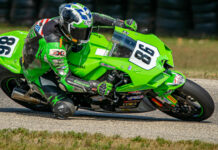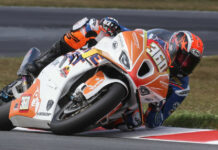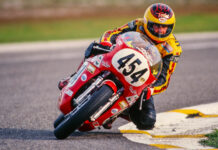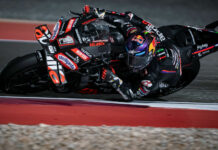In a private meeting held Thursday at Barber Motorsports Park, Daytona Motorsports Group’s (DMG) Roger Edmondson presented his 2009 plans for AMA Pro Road Racing to a group of representatives from the Japanese motorcycle manufacturers that currently participate in the AMA Superbike series. Following the meeting, Edmondson shared those plans with Roadracingworld.com. According to DMG’s presentation, there will be four classes of racing in 2009: Daytona Superbike, LiterBike, MOTO-ST and a specialty racing series — the Red Bull AMA U.S. Rookies Cup was given as an example. Daytona Superbike will be the premier class and will race twice on a typical weekend, once on Saturday and once on Sunday. It will have a rule structure designed to “promote parity and competition” among Twins, Triples and four-cylinder machines, allowing participation from the maximum number of brands from around the world. DMG’s presentation states that 10 manufacturers (Aprilia, BMW, Buell, Ducati, Honda, Kawasaki, KTM, Suzuki, Triumph and Yamaha) currently offer a motorcycle eligible for the class. Daytona Superbike will be open to “homologated and available motorcycles,” will include “middleweight performance horsepower limits” and will have “targeted and specific power-to-weight ratios” (rider weight included). The class will have a single tire supplier, a single fuel supplier, regular Engine Control Unit (ECU) exchanges and only “homologated, available and affordable aftermarket components” will be allowed. MOTO-ST will continue, essentially, as it has since it started, with three horsepower- and weight-regulated classes for homologated twin-cylinder motorcycles: Super Sport Twins (120 maximum horsepower, 400 pounds minimum weight), Grand Sport Twins (90 maximum horsepower, 380 pounds minimum weight) and Sport Twins (75 maximum horsepower, 360 pounds minimum weight). MOTO-ST will continue to use a single tire supplier and a single fuel supplier. LiterBike will include manufacturer homologated motorcycles, “industry/AMA developed rules for 2009 and 2010,” a single tire supplier, a single fuel supplier, a “specified minimum participation level required to maintain eligibility,” a “maximum participation level will be specified” and riders will be required to hold a Class I, or “Master” license in order to participate. The presentation did not specify displacement limits or eligible engine configurations for LiterBike but insiders say that the class is likely to follow the 2009 rules developed for AMA Superbike by an AMA rules committee in 2007, including 1000cc Fours and 1200cc Twins. Riders in Daytona Superbike will also be required to hold a Class I license. Class I and II license holders will be allowed to race in MOTO-ST Super Sport Twins. Grand Sport Twins competitors can hold a Class II or III license. Class III license holders will be eligible to race in Grand Sport Twins, Sport Twins and the specialty classes, like the Red Bull AMA U.S. Rookies Cup. The presentation included an example of how a race weekend will be structured. Day One will include move-in and parking, tech inspection, press announcements and interviews, VIP and sponsor rides, and practice, one hour each for Daytona Superbike and LiterBike and two hours for MOTO-ST. Day Two will include practice and qualifying for all classes, pre-race ceremonies and “Fan Walk,” Daytona Superbike race one (one hour maximum) and a 250-mile MOTO-ST race (three hour maximum). Day Three will include warm-up sessions for Daytona Superbike, LiterBike and the specialty class; on-track fan activities; pre-race ceremonies and “Fan Walk;” Daytona Superbike Race Two (one hour maximum); specialty race (40 minutes maximum); LiterBike Race (one hour maximum). Stay tuned for more information, including detailed technical rules.
Daytona Motorsports Group Announces 2009 Plans For AMA Pro Road Racing
Daytona Motorsports Group Announces 2009 Plans For AMA Pro Road Racing
© 2008, Roadracing World Publishing, Inc. From a press release issued By David Swarts.






